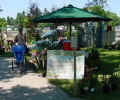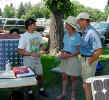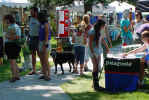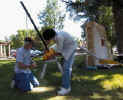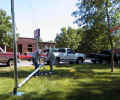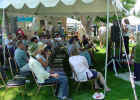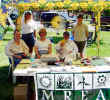![]()
Â
Â
- Clean Energy, Efficiency Key to America's (and Montana's) Future
- Sage Mountain Center Wins Sustainable Education Award
- MAGIE Exhibit Generates Interest in Wind, MREA
- Pair Uses Renewable Energy to Live Lightly, Help Others Do Same
- First Steps for the Energy Consumer
- MREA Takes Part in Sustainability Fair
- Chris Daum Reports on the Midwest Renewable Energy Fair
- Chris Borton Shares His Energy Views with Whitehall Newspaper Readers
- Sage Mountain Center among Eco Star Award Winners
Dave Ryan, president of the Montana
Renewable Energy Association, replied to a guest editorial that appeared
in the June 16, 2003, issue of the Billings Gazette
Clean
Energy, Efficiency Key to America's (and Montana's) Future
By Dave Ryan, President
Montana Renewable Energy Association
I represent a group dedicated to promoting renewable
energy in Montana. We take issue with a June 16 guest
opinion "Don't waste money on renewable
energy."
Because the United States imports over half its oil we
must find reliable, domestic sources of energy. Health
concerns demand that we use clean energy.
Efficiency is the cheapest, cleanest and most reliable
energy. High-efficiency equipment is available, and we
should install it whenever replacing older, less
efficient equipment.
Wind, solar and biomass energy are renewable, clean
and local. These can contribute significantly to a
reliable energy supply. Denmark and northern Germany
supply over 20 percent of their electricity needs with
wind. One reason they have so much wind power
installed is they have public policy encouraging clean
generation.
Renewable portfolio standards (RPS) are a part of this
policy. According to a 2001 study done by the Energy
Information Administration of the U.S. Department of
Energy, a 20 percent RPS would cost the same as
business as usual through 2006, would result in a 0.7
percent increase in energy prices by 2010, and would
result in lower prices by 2020.Â
Colorado policy
In 2001, the Colorado PUC ordered Xcel Energy
(formerly Public Service Company of Colorado) to add
wind power to its supply because the cost of wind
power is cheaper than power generated using natural
gas if the gas is more than $3.50 per MCF (thousand
cubic feet). According to the EIA, the average gas
price to utilities in 2001 was $3.77 per MCF. Gas
futures were trading recently (June 19, 2003) on the
New York Mercantile exchange at over $6.00 per MCF.
Since 1978, the federal government has spent $11
billion of taxpayer money to encourage renewable
energy.
This number compares to $5 billion dollars PER YEAR of
federal subsidies for the petroleum industry from 1916
to 1978, and $145 billion for the nuclear industry
since 1947. The current energy bill includes $16
billion in subsidies in the form of loan guarantees
for nuclear in a single piece of legislation.
One benefit of creating electric energy from the sun
or wind is that the fuel is free. Renewable energy can
be a hedge against fuel cost increases. While the cost
of natural gas has risen, the cost of renewables has
fallen. It is true that wind and solar is
intermittent, and siting wind power plants should
avoid impacting views or wildlife. We support
development of technologies able to follow electric
loads on a utility scale. We prefer that these
technologies use renewable fuels wherever possible.
According to the EIA, 8 percent of the electric energy
generated in 2001 was generated by renewable sources,
2.1 percent with non-hydroelectric renewable energy.
We believe strongly that these numbers will grow
substantially before 2025.
According to the New York Times, the wholesale price
of ethanol is less than of gasoline. Blended ethanol
fuels should be cheaper at the pump than straight
gasoline, and they are less polluting. Ethanol is
replacing MTBE, a petroleum-based gasoline additive,
increasing market demand for ethanol.Â
Park uses biodiesel
Biodiesel, another clean fuel is used now in all
diesel machinery in Yellowstone Park. Diesel engines
can use 100 percent biodiesel. In Germany, biodiesel
is available at gas stations.
London air in the 1600s was so polluted by the burning
of coal that British scientist John Evelyn wrote that
breathing problems "rage more in that one city
than the whole earth besides." Though our air is
now cleaner than London's in the 1600s, there is
little debate over the source of global warming. Two
thousand scientists on the International Government
Panel on Climate Change agreed that human activity is
altering global temperatures and weather patterns.
We believe that carbon emission credits should be
traded. Because of the Kyoto Protocol, a global market
has emerged for trading carbon emission credits. Many
large companies engage in carbon trading on the
Chicago Climate Exchange. A voluntary approach for
carbon trading has been embraced by the Bush
administration.
The effort advocating energy bill amendments to reduce
greenhouse gases has the support of farmers, industry,
environmentalists and economists. This broad support
shows that the status quo contributes to our
dependence on foreign oil. Suppose we got cut off from
Middle East oil. Why wouldn't we explore clean and
abundant energy sources existing here in the United
States? Renewable energy can provide for electricity,
heating, and transportation. Renewable fuels yield
more than just energy, they create jobs and tax
revenue and keeps our money in the United States
instead of exporting it to the Middle East.
Copyright (c) The Billings Gazette, a division of Lee
Enterprises.
Sage
Mountain Center Wins
Sustainable Education Award
Sage Mountain Center
of Whitehall recently received the Corporation for the Northern Rockies
Sustainable Education Award. The award is given for "outstanding
leadership in educating the public about sustainability and energy
conservation."
The award ceremony took place at the annual Sustainability Fair in
Livingston on July 13. The Fair drew several thousand visitors and the
included 80 or so booths and displays set up by vendors, non-profits and
government agencies in Rotary Park next to the Historic Depot Center in
downtown Livingston.
The 2002 theme was "Shining a Light on Sustainable
Choices." Fair-goers could learn how to cope with rising gas and
energy prices and take the first steps toward energy independence by
learning how to get off the grid. They sampled (or bought) fruits and
vegetables from a sustainable garden, tasted produce and meat from local
farms and ranches, strolled through native and drought resistant trees and
shrubs, discovered healthful and environmentally friendly apparel,
cosmetics, and home products, and viewed cutting-edge energy technologies
and building materials.
The Education Award was one of four categories including: Trendsetter,
Innovator, and Sustainable Agriculture.
Sage Mountain Center, a charter member of the Montana Renewable Energy
Association, is operated by Christopher Borton and Linda Welsh and
provides workshops, seminars, and tours dedicated to promoting deeper
awareness of self and environment.
Sustainability Fair 2002 - MREA Snapshots
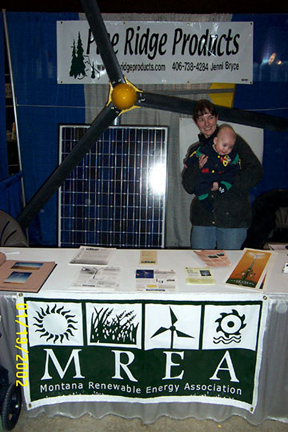 MAGIE
Exhibit GeneratesÂ
MAGIE
Exhibit GeneratesÂ
Interest in Wind, MREA
Logan and Jenni Bryce of Pine
Ridge Products in Great Falls spent three days at the MAGIE (Montana
Agricultural Industrial Expo) Jan. 17-19 at the Four Seasons Arena in the Electric City.
Over the three days they handed out more than 750 Bergey Excel 10KW flyers and 450 XL.1 and 1KW flyers ("We need a grid-tie version," Logan Bryce says). They also promoted the Montana Renewable Energy Association and handed out 250 Montana Green Power postcards and MREA brochures. "Our booth was one of the busiest at the show," said Bryce. "The interest in wind power in our state is huge, and the demand for information on the subject was overwhelming."
He said he underestimated the work involved, "if your subject is
one that creates interest."Â
"Towards the end we were glad it was the last day, as our voices were
almost gone."Â
The Bryces thanked everyone who helped them in the show,
including Bergey Windpower, the National Center for Appropriate
Technology, MREA, "and yes, indirectly, Montana Power, who will be
getting flooded with grant requests."
Bryce said he�s not sure how much product will be sold, "but everyone left with a better understanding of wind power, net metering, and the difference between electric coops and Montana Power when it comes to home and farm wind power production and net metering."
Walking the walk:Â
Sage
Mountain Uses Renewable Energy
to Live Lightly, Helps Others Do Same
By Roberta Forsell Stauffer
The Montana Standard
Their dream car is an SUV that could run on either gas or electricity. The sport utility vehicle would start in 40-below zero weather and be equipped with four-wheel drive to navigate the rough roads along the Continental Divide. One deep charge of batteries would be power enough for the 40-plus-mile round trip to Butte.
For Chris Borton and Linda Welsh of Sage Mountain Center, that dream car represents a major "missing link'' in their quest to live with little impact on the planet and help others do the same.
� Details...
Back to the top
First Steps for the Energy Consumer
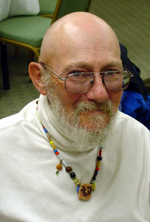 We negate part of our need
to consume resources if we practice conservation first. Efficiency in
end-use applications is equivalent in increase in energy supply. We work
with the customer to establish energy use. In other words, we complete an
energy inventory.
We negate part of our need
to consume resources if we practice conservation first. Efficiency in
end-use applications is equivalent in increase in energy supply. We work
with the customer to establish energy use. In other words, we complete an
energy inventory.
We think, sometimes, that having said something a few times that it will nevermore need rehearsing. But clearly a realistic energy inventory take with the consumer is necessary, which means we have to tell customers either to have no kids or to install motion-sensor light switches, to replace inefficient appliances with high-efficiency appliances, to install energy-efficient lighting, etc. So, we do two inventories: one with no conservation (the consumer in the dark) and one with conservation features worked out with the customer (the illuminated consumer).
The result may be that some customers have plugged their cash leaks and will have no further need of us, except to purchase the occasional light fixture.
In this spirit, I suggest, as a first step, the adopting of high-efficiency lighting. For closets and pantries used less than 20 minutes at a time, install 40-watt quartz halogen lights. For area lighting, high-efficiency fluorescent fixtures yield about 5:1 efficiency improvement.
So much for the big; now for the small, namely "Phantom Loads." LED�s (light-emitting diodes) those little jewels of red, green and yellow light that pierce the darkness when all the others lights are turned off. One of those little guys will consume one amp-hour of current in 12� days. Many appliances have them. Some LED�s are on all the time: clocks, VCR�s, telephones, smoke detectors, surge protectors, etc. A number of appliances (instant-on televisions, for example) use a lot of power when off but still plugged in. Some VCR�s use almost as much power when merely plugged in as they do when they�re in use. Outlet strips with on-off switches work great. Flat screens usually use less power than tube-type monitors. PIR motion detectors are effective light controls if several of them are connected to one power supply.
We can start small and be effective in reducing demand. By a little and a little are modern struggles won.
Mikey Strickland
Dearborn Solar Electric Co.
633 Dearborn River Rd.
Cascade, MTÂ 59421
406-788-7023
Â
MREA
Takes Part in Sustainability Fair
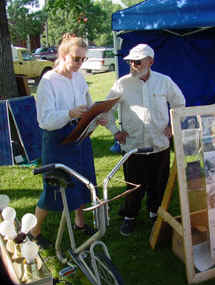 Members
of the Montana Renewable Energy Association staffed a table at the
Sustainability Fair 2001 Aug. 25 in Livingston
Members
of the Montana Renewable Energy Association staffed a table at the
Sustainability Fair 2001 Aug. 25 in Livingston
Organized by the Corporation for the Northern Rockies, the Fair featured a full day of exhibits, activities, speakers and performances about everything from recycled building materials to strategies for cutting energy costs.
CNR is a Livingston-based nonprofit providing education and technical support to sustain the Northern Rockies landscape and way of life. "The intent of the Fair is to bring sustainability in all its facets to Montanans," said Lill Erickson, CNR Executive Director.
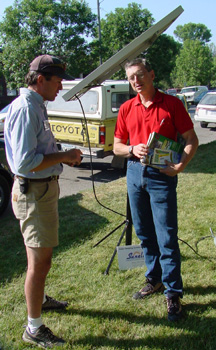 The
Fair featured some 60 vendors and eight speakers covering a variety of
topics including sustainable ranch management, local food, drought
tolerant landscaping, alternative building materials, and the newest
electric hybrid cars.
The
Fair featured some 60 vendors and eight speakers covering a variety of
topics including sustainable ranch management, local food, drought
tolerant landscaping, alternative building materials, and the newest
electric hybrid cars.
MREA members who helped at the Fair included Mikey and LuMarie Strickland of Dearborn Solar Electric; Dave Ryan of Montana Power Company; and John Walden and Jim Tracy of the National Center for Appropriate Technology. MREA enjoyed the use of a solar pumping demonstration system from Sunelco, a "sunflower" canopy from Solar Plexus and a wind turbine from Pine Ridge Products.
Other MREA members who participated in the Fair included Bob and Hopie Stevens of the Fanwood Foundation, Linda Welsh of Sage Mountain Center, and William von Brethorst of Planetary Systems.
Report from the Midwest
Renewable Energy Fair
WHAT IS MREF? Many years ago, in central Wisconsin, there was a pocket of
farms, an Amish community. When electrical power was put in to the region,
it was not provided to this patch of farms. After a while, many of the
Amish moved elsewhere--and the people who bought their places largely
decided to put in off-grid power systems. As time went by, they decided to
have an educational celebration to show folks what they were doing and
how. Thus the Midwest Renewable Energy Association, http://www.the-mrea.org
was born, and their annual celebration of renewable energy technologies is
now the present fair. This year's renewable energy fair near Amherst, WI,
was June 22nd through June 24th. So much to see and so little time....
Read more about Chris' impressions of the fair at the Oasis Montana, Inc. website.
The following two-part interview with MREA board member Chris Borton appeared in the June 20 and June 27 (2001) issues of the Whitehall Ledger. It is used here with permission of publisher Glenn Marx.
Renewable Energy Makes
Economic Sense,Â
Says Sage Mountain Center FounderÂ
Chris Borton and
partner Linda Welsh have owned and operated Sage
Mountain Center, located in the Toll Mountain area west of Whitehall,
since 1991. Sage Mountain Center offers training in personal inner growth,
physical health and sustainable living. The sustainable living portion of
the Sage Mountain experience offers a wide variety of advice and courses
on a range of topics, including solar home design, alternative building
materials, solar electricity and more. Borton, a Georgia native, is the
fourth generation of his family to work in construction.
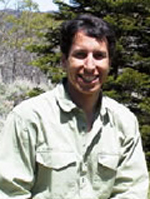 Q:
There�s a lot of talk about energy conservation right now, but some
people seem disinterested or almost fearful of the topic. Why are people
uncomfortable with the concept of conservation?
Q:
There�s a lot of talk about energy conservation right now, but some
people seem disinterested or almost fearful of the topic. Why are people
uncomfortable with the concept of conservation?
A: I think conservation is generally seen as deprivation, or having to do without. If we think in a larger context, part of being an American is independence, and having abundance�having as much as we want when we want it.
We�re huge consumers. We consume more energy than any other country in the world. Anytime a word comes into our vocabulary that has to do with changing our life and having to do with less, our tendency is to immediately resist that.
Q: What do you think has to happen to change that mindset?
A: I think the first thing is for people to make the connection�to connect the energy we use with where that energy comes from. In other words, when we turn on a light, think�where is that power coming from, how is it produced, how much does it cost to produce? People seeing the connection of our everyday living and seeing how it relates to the bigger picture of our community, our state and our country.
Q: What has to happen for that kind of understanding to begin to take place?
A: I think generally in the past, coming out of the 1980s, there was a lot of idealism about solar energy and wind power and how it would save us with of all of us living happily ever after.
But what we�re seeing now is kind of interesting because it is starting to hit us in our wallets. I believe it is our wallets that are going to cause us to change and think differently about conservation.
Q: Speaking of wallets, in 1997 the Montana Legislature passed an energy deregulation bill. The law is being phased in, and energy deregulation will hit residential consumers next year. How do you see energy deregulation playing out in Montana?
A: My gut feeling is we already know there are going to be increases � 50 to 100 percent � and as it looks now it�s going to be stuck on us. Energy costs are going to get a little higher, and we�ll get used to that, and a little higher and we�ll get used to that�
Our power bills are definitely going to be going up. I think all that will increase our awareness of our connection with where we get our power from and how we use our power, and it is going to make us generally more conscious. And I think if we are conscious of these things we�re more inclined to act on them.
Q: What is your response to President Bush�s national energy plan?
A: It needs a lot of work. Right now, I believe the government is seeking comment about where renewables are perceived by the general public. I think it�s crucial we do provide feedback to increase the usage of renewable energy in his energy plan.
Obviously there is a strong tendency toward fossil fuels in the plan. I think that�s very bogus. It�s going in the wrong direction.
Q: In a realistic sense, what can government do to address the energy supply crisis?
A: I just read where Governor Judy Martz is encouraging state agencies to conserve, and I see that as a positive gesture. I think what we really need � what the general public and small businesses really need � are education and incentives. Two simple terms.
Q: What kind of education and incentives?
A: Education, which is part of what we do at Sage Mountain Center, is to teach people that they don�t need to use as much energy as they�re using. They can do their dishes, do their laundry and heat their house all to the comfort level they are used to, but using a tremendous amount less of energy by using more energy efficient appliances.
Incentives could be as simple as something like rebates for appliances and light bulbs. It�s easy for states to plop down $100 million in tax breaks for the development of fossil fuel power plants. Why not take the $100 million and distribute compact fluorescent bulbs to an entire state, and watch the power consumption drop tremendously. Then we wouldn�t have to build new polluting power plants.
Q: What kind of specific activities is Sage Mountain Center doing to promote energy conservation?
A: We�re doing a collection of seminars geared toward education on solar electricity�how and why to incorporate that into your business or your home. We�re looking at passive solar home design, energy efficiency in building and construction techniques. We also offer free tours of the facility here at Sage Mountain Center, where people can see these super energy efficient measures.
Q: Right now we�re looking at the new home you�re building at Sage Mountain Center. What are some of the super energy efficient measures you�re building into the structure?
A: The first thing is the orientation of the building. It�s oriented to take maximum advantage of the sun�s heating capabilities in the winter. We are creating a very well-insulated shell of the house. We�re using plastered straw bale construction, which has an R-value of about 40. It�s a very renewable material�we get it fifteen minutes away at the Smith ranch. We can see our walls grow one season and the next season we�re building with them.
After building a very well-insulated home we include systems in the home, and we try to use the sun and wind as much as possible for electricity and heating.
We�re in the process of putting up a wind generator. We�ve been living on 100 percent solar electricity for the last ten years. Sage Mountain Center has never paid a power bill.
We�ve gone with an in-floor central heating system, also called radiant floor or radiant heat system, for the central heating system. That system circulates hot water through tubing in the floor, and that hot water is heated from the sun. Pumps circulate the water throughout the floor, and it is the cleanest and cheapest form of central heating you can have right now when it is put in during new construction.
Our solar electric system consists of a solar array outside. Sunlight hits those panels and excites electrons, and the electrons get channeled into a battery bank, and the battery bank is used for nighttime electricity. And in the daytime it�s recharged by sun.
All the lights throughout the house are new compact florescent lights. When you say florescent lights most people think of white, pasty, buzzing, flickering lights. The new generation of compact florescent lights has not one of those unpleasant features. We also use LEDs (light emitting diodes) which is the absolute most efficient lighting right now.
Q: These are all built-in costs to the home, as well. How much does all this stuff cost up front, and how much do you save in the long run?
A: Generally, for appliances, the more efficient the appliance is, the more expensive it is up front. But the operating cost over the life of that appliance will be much, much lower than a standard appliance. An energy efficient appliance will save you a tremendous amount of money in the long run.
For example, a compact fluorescent bulb will cost about seven dollars, and last about seven to ten years. One bulb will save about forty bucks over the life of that bulb. One, because you won�t be changing light bulbs as much. Incandescent bulbs last only a year or so. Two, these bulbs use much less electricity than incandescents. I call incandescent lights "heaters," not lights. Ninety-percent of an incandescent light bulb is heat, and ten percent is light.
For construction of a new home, generally energy efficient measures add about ten percent to the cost of a home. But they can save as much as forty percent on the operation of the home.
(Next week: Borton talks about the "How to�s" of solar power, his vision of energy use in America and sources for more information of renewable energy.)
Chris Borton, of Sage Mountain Center, discussed the concept of energy conservation, Sage Mountain Center programs and seminars, and overall benefits of energy conservation last week in part one of the "Catching Up With" interview. Part two of the interview focuses more on the "how to�s" of solar power and possible future use of renewable energy.
Q: How does solar power figure in the general concept of renewable energy?
A: First, we need to make the distinction between the types of solar energy. There are three types of solar energy available to homes. One is passive solar space heating. That�s the heating of air.
Second is solar electricity. That�s the creation of electricity from sunlight.
Third is solar hot water.
That�s where water is heated from the heat of the sun.
Q: Do solar panels work for all three of those functions?
A: It depends on what kind of panels you�re referring to. Solar hot water panels can help offset your heating bills, whether it�s forced air, natural gas or propane.
Solar space heating or passive solar home design can also offset heating bills.
Solar electricity cannot help offset home heating bills. It can only help offset your electric bills. A lot of people think that if they put some solar panels on their house, their heating bill�s going to go way down. Won�t happen. Solar electricity can never be used in conjunction with electric heat, because it takes so much electricity to create heat that it would be extremely inefficient to use solar electric panels for heating. So solar electric panels should only be used to offset electric bills as it relates to lights, appliances, power tools, things like that.
Q: If someone is interested in learning more about solar panels, what is their first step and how do they proceed?
A: First step is to talk to us at Sage Mountain Center (laughs). We teach a lot of classes, we have a lot of resources and a lot of connections for people who are interested in learning more about this stuff. The Internet is flooded with information about every type of solar power. There are lots of great books and videos out there for people interested in learning more about solar or wind power.
Q: What is the best Internet site for solar energy and renewable energy information?
A: The best website right now is www.montanagreenpower.com. That�s a new website, and it is the most comprehensive site for the state. It has all kinds of renewable energy information, and also has the latest news from around the country, and keeps you up-to-date on legislative actions and grants that are available, and has links to several other good renewable energy sites.
And attend our Sage Mountain seminars.
Q: If solar panels make so much sense, why aren�t they on every home. Why aren�t they standard features on new homes?
A: They will be at some point.
Right now, the cost of solar electric panels is still pretty expensive. That�s why most people aren�t using it now�because of the initial investment. The analogy I like to use, however, is the comparison between solar panels and a new SUV. We�ll go out and spend $20,000 to $40,000 for a new car or SUV, and if you think about it, that automobile is probably the worst investment you�ll ever make. It costs thousands of dollars a year in fuel, it costs us for insurance, and as soon as it leaves the lot the price drops immediately. So as an investment, a vehicle is a real bad choice.
Let�s compare that to a solar electric system. The cost is anywhere between $7,000 and $17,000. It�s an investment. But this investment can offset all or almost all of your electric bills for at least fifty years.
One thing to keep in mind about renewable energy is that the United States is basically still in the Dark Ages. When we look at places like Europe, they are so completely advanced and ahead of us, it�s embarrassing. Even if we compare ourselves to developing countries in places like Africa, the United States is still way behind. Because developing countries don�t have the (energy) grid, these remote forms of energy are clean and self sufficient and just springing up all over the place.
Q: Montana has plenty of wind, but not a lot of wind power. Why isn�t there more power generated from wind, and how practical is wind power?
A: Wind power is extremely practical in Montana. We are the fifth windiest state in the country, and Montana has some of the windiest areas in the country.
The reason it isn�t popular right now is basically because the whole energy market has been dominated by coal and hydro.
As far as wind is concerned, that�s changing very rapidly. I know of a number of site assessments taking place for wind farms in Montana. And wind power is going to happen here. The first one is already going up right now on the Blackfeet Indian Reservation. That�s one of the windiest spots. Livingston is another key area, of course, as are places like Anaconda.
Q: Is a wind farm practical in the Whitehall and Jefferson Valley area?
A: Yes. Absolutely.
Q: Montana Power offers home efficiency audits. Should homeowners look into these?
A: The Montana Power energy audits are an excellent way for customers to have their house assessed. It�s free, and everyone should have it done, for sure. There�s nothing to lose.
Q: What�s a fuel cell, how do they work, and how practical are they?
A: Fuel cells operate somewhat like a regular car battery. They require hydrogen, which is transformed into electrical energy and some heat.
Right how, of course, there is a lot of research being done on fuel cells, mostly for vehicles. There are fuel cell vehicles out there. They�re starting to be made on the commercial market, and we�re going to see them more in the residential market. They�ll be treated something like a generator. A fuel cell, however, isn�t considered a renewable or clean form of energy, unless the hydrogen comes from a clean source. Right now, the majority of fuel cells that are out there can use propane or natural gas. They extract the hydrogen from a fossil fuel.
There�s a lot more work being done now to extract that hydrogen from water. Hydrogen is the most abundant element in the universe, and we can extract hydrogen from water. And that�s going to be the future of energy production from a hydrogen source, in my opinion.
Q: Hydrogen, as in the hydrogen bomb? How is hydrogen converted into energy?
A: I�m not a chemist or a physicist, this is just stuff I�ve learned over the years. But yes, people think of hydrogen as something blowing up, like the hydrogen bomb.
However, we�re dealing with very explosive, very flammable materials every day when we use gasoline for our cars, propane in our barbecues, natural gas for cooking. Those are potentially very dangerous materials.
Hydrogen is sort of a new fuel for us, and the more we�re exposed to it, the more comfortable we�ll be with it.
Q: Let�s look ahead 100 years. How will the construction and operation of an average home differ from homes now?
A: I can imagine the home being predominately built from recycled materials�recycled from anything�tires, plastics, metals, and you might see paper and cardboard created into lumber. There have been some big advances there.
I can imagine the home being built in harmony with its environment, where the water that comes in is monitored and the water that goes out is monitored to make sure it�s just as clean as when it came in. The fuel heating the home and supplying electricity for the home will also be clean from the sun, and from hydrogen extracted from water. Our vehicles will be zero emissions, and will be powered by the water and sun. Incidentally, this is happening now, only on a small scale.
Q: What are three simple things people can do to start conserving energy as soon as they put down this newspaper?
A: The first cheapest and most effective thing you can do is change out your light bulbs. Any light bulb you have on for more than one hour per day�change that light bulb to a compact fluorescent. It�s a small investment you�ll make initially (usually about $100 to replace all the light bulbs in a home), but you�ll see immediate results in your power bill.
The second thing is seal up cracks in your house. Infiltration is a big energy waster�heat and cold going in and out around doors and windows. The typical door that you feel the air coming in and blowing around the seams of the door is the equivalent of a six-inch round hole in your wall. So with every door and window that is the equivalent of a six-inch hole you are essentially heating the outdoors, or cooling the outdoors if you run an air conditioner.
The third thing is a clich�,
but you should turn off lights when you�re not in the room, and replace
your inefficient appliances with new ones.
Back
to the Top
Sage
Mountain Center among Eco Star Award Winners
MREA member Sage Mountain Center near Whitehall is one of 22 small
businesses throughout Montana that have qualified to receive special
EcoStar recognition from the Montana State University Extension Service
for its efforts to reduce waste.
Sage Mountain Center was built using energy-conserving construction techniques. Low toxicity "natural" cleaners are used, most of the lighting is by efficient compact fluorescent bulbs, and water use is reduced through low-flow fixtures and faucets. All staples and cleaning supplies are purchased in bulk, and they recycle. The Center estimates its annual savings from P2 efforts at $3,000.
The EcoStar recognition program is an effort by Extension's Pollution Prevention (P2) Program to publicly recognize environmentally conscious businesses in Montana. This year's winners, ranging from dry cleaners to restaurants (see list), were chosen from among scores of Montana businesses for their commitment to waste reduction, resource conservation, and employee and customer education about reducing waste, according to Jon Hudson, MSU Extension pollution prevention specialist.
EcoStar applicants are reviewed by a panel of pollution prevention professionals, and receive an on-site visit to assess their environmental performance. Businesses selected as "EcoStars" receive window decals, award certificates, display ads, marketing materials and media coverage.
The goal of the EcoStar program is to provide businesses with incentives to reduce waste, and to help consumers make more informed purchasing decisions, says Hudson. Increasingly, consumers are seeking products and companies that are environmentally responsible. EcoStar recognition can create a competitive advantage for these businesses by helping them attract new customers, enhance customer loyalty and boost employee morale.

